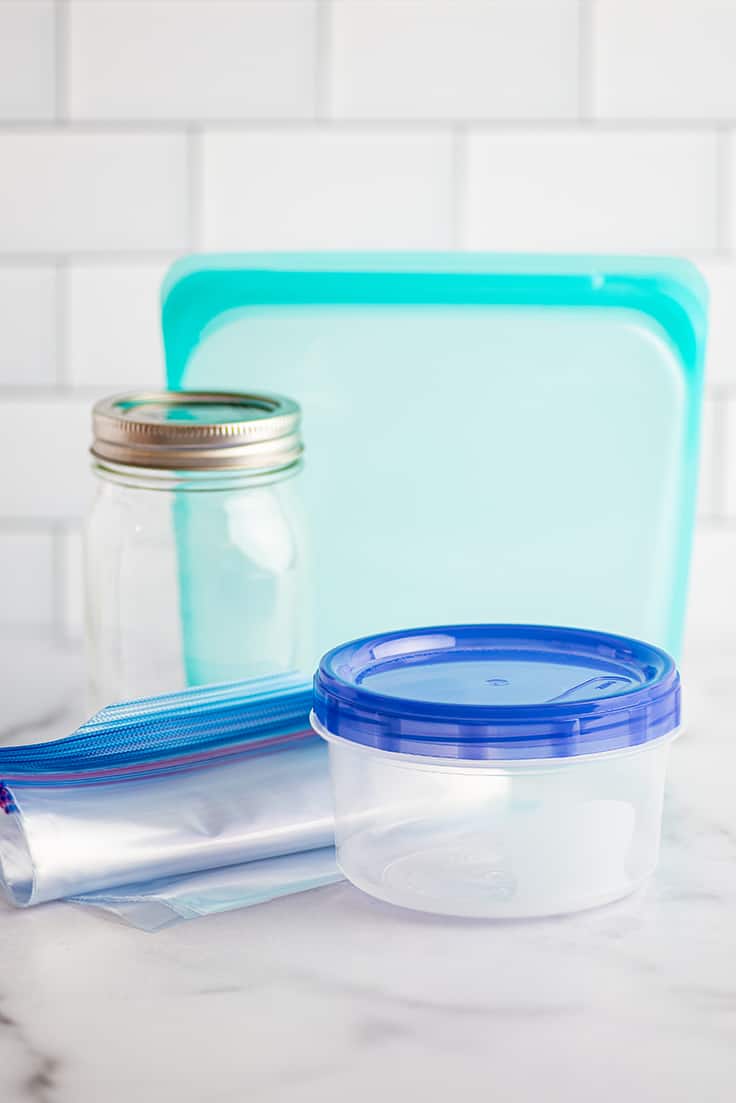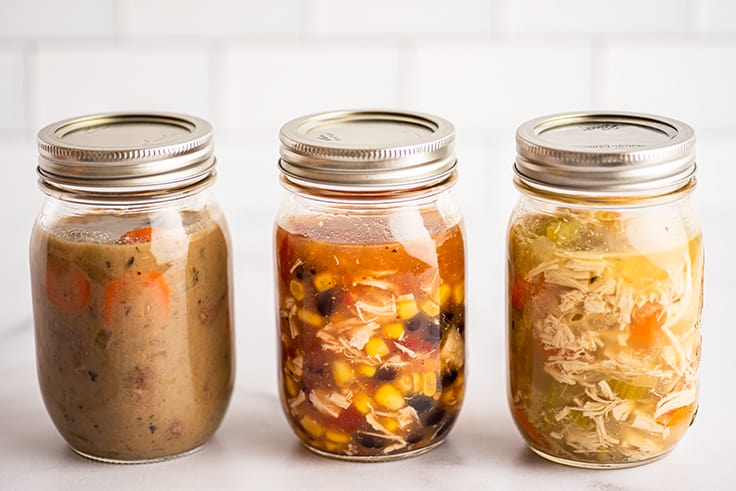Your complete guide on how to freeze soup from the best soups to freeze to what containers to use. Plus a ton more tips and tricks.
A few weeks ago, in my freezer burritos post, I talked about how freezing meals for the future is one of the kindest things you can do for yourself.
It’s something I wish everyone could find time to do because knowing you have a ready-to-go meal in your freezer is such a relief after a long day.
And since the weather is turning colder, I thought today would a perfect time to talk about one of my favorite foods for freezing: soup.
Can you freeze soup?
Yes! Soup freezes and reheats so, so well. Even better, you can store it in a variety of containers so you pretty much always have space in your freezer for some soup.
That being said, certain soups freeze better than others. Some ingredients degrade or separate or bloat in the freezer and this can change the texture of frozen and reheated soups.
Some soups you can freeze fully cooked, others you’ll want to modify before freezing for the best results.
The Best Soups for Freezing
Clear and vegetable-based soups without pasta, rice, or potatoes: Things like Chicken Taco Soup with lots of chicken and beans can go straight from stove to the freezer and reheat beautifully without any modifications.
Freezing Tip: All vegetables will be slightly softer after freezing and reheating. If you prefer your veggies with more bite, undercook them just a bit before freezing so they are firmer when you finally eat them.
Soups That Need Some Modifications for Freezing
Part 1: Soups With Dairy
This includes soups with cheese, cream/milk, and roux-based soups. Dairy in soups can separate and cheese and roux-based soups can become grainy when frozen.
How to Freeze Soups With Dairy
This is a really simple fix: leave the the dairy out if possible.
- Make the soup recipe as written up to the point of adding the dairy and then freeze.
- When you’re ready to serve the soup, defrost, heat, and add in the dairy.
This even works with soups made with a roux. When your soup base is defrosted and reheated, make the roux and stir it into the soup.
A Note on cream and milk-based soups: Even though they tend to separate when frozen, many people, myself included, will sometimes choose to freeze soups with milk and cream in them. This is because they usually come back together pretty well with a good stir.
The texture is often not quite as nice as when made fresh, but sometimes you have milk/cream that’s about to expire and it’s easier just to freeze everything now. If you’re not sure if you’ll mind the texture change, try it once and see how you feel about it. I find that it’s usually more of an aesthetic issue than a taste one.
Part 2: Soups With Starches Like Pasta, Rice, and Potatoes
Rice and pasta tend to bloat when frozen and potatoes will become mealy and fall apart. Some people don’t mind this, so you definitely can freeze soups with these ingredients, but their texture won’t be the same as freshly made soup.
How to Freeze Soups With Starches
A better option is to treat these ingredients as you would dairy and simply omit them while cooking.
- Freeze the soup without the pasta/rice/potatoes.
- When you’re ready to reheat the soup, cook the pasta/rice/potatoes separately and then add them to the reheated soup. You can do this for the whole recipe or individual servings.
What is the best container for freezing soup?
You have a few options for soup freezing containers, and they all have their pros and cons.
Plastic Storage Containers
- Pros: Cheap (usually), easy to fill, reusable
- Cons: Made of plastic, less durable than glass (long term), can be bulky in the freezer, can pick up stains and smells
Mason Jars
- Pros: They look nice, relatively cheap, easier to fill than bags, will last basically forever
- Cons: Can break, must defrost completely before pouring soup out, bulky and not stackable in the freezer
Plastic Freezer Bags
- Pros: They’re cheap, easy to stack and store in small places, can be reused once or twice
- Cons: Not very reusable, hard to fill, made of plastic, can rip or be punctured in the freezer
Silicon Freezer Bags
- Pros: Reusable, most are dishwasher safe, easy to stack and store
- Cons: Fairly expensive, not super easy to fill
My preference: I do most of my soup freezing in quart-size freezer bags (I like to freeze soup in individual portions). I’m also a big fan of the silicon freezer bags, but at $10+/bag for some brands, they’re a little too pricey for me to wholeheartedly recommend to everyone.
How to Freeze Soup
1. Cool
Always, always, always cool your soup to room temperature before freezing. Putting warm food in your freezer can raise the temperature of your freezer and cause the foods around it to begin to thaw and/or melt.
2. Label and Date
Never put anything in your freezer without a label and date. You think you’ll remember that this bag of red stuff is the tomato soup that you made on October 2nd, but I guarantee, by Nov 2nd, you won’t!
3. Freeze
Jars and plastic storage containers can go right into your freezer. If using freezer bags, stack them on a flat surface like a cutting board or small baking sheet (I usually use my quarter sheet pan) and freeze until solid. Once frozen solid, you can stand the bags of soup upright and file them in wherever they’ll fit.
4. Defrost
Defrost soup overnight in the fridge. If using a disposable freezer bag, it’s always smart to put your soup on a baking tray or in a large bowl just incase it was punctured at all in the freezer so you don’t end up with soup leaking everywhere.
For single servings in freezer bags, you can also place them in a bowl of warm water, and they will defrost in about 15 minutes.
For quicker defrosting with most other containers, place the container of soup in a bowl/sink of warm water for about 5 minutes until the sides have melted enough for the frozen soup to slip out of the container. Dump the frozen soup in a pot and melt/reheat the soup very gently over medium heat.
5. Reheat
Reheat defrosted soup in the microwave or gently on the stove. Don’t try to microwave frozen soup unless it’s as a last resort. The amount of microwave time needed to reheat frozen soup will seriously overcook most ingredients in the soup.
Freezing Tip to Prevent Freezer Burn: The cause of freezer burn is air which allows ice crystals to form. To prevent this, squeeze all excess air out of freezer bags so there’s no chance for it to form. For jars and plastic containers, you can take a piece of plastic wrap and press it over the surface of the soup.
FAQ
How to freeze soup in individual portions?
Freezing soup in individual portions is no different than freezing full batches. You just need smaller containers. This is actually my preferred way to freeze soup. When your soup is cooked, simply divide it between your storage containers.
If it’s a soup with dairy or starches and you’ve held back an ingredient, divide that ingredient by the number of servings and make a note on the label of what was left out and how much of it to add to the soup after reheating.
How long will soup last in the freezer?
Soups are best when consumed within 2 to 3 months of freezing. They’re safe to eat past that, but you start to run the risk of freezer burn the longer they’re in there.
Favorite Soups for Freezing
- Simple Beef Stew (omit the potatoes until ready to serve)
- Creamy Chicken Noodle (omit the pasta until ready to serve)
- Quick Chicken Tortellini Soup (omit the pasta until ready to serve)
- Easy Chicken Parm Soup (omit the cheese and pasta until ready to serve)
- Chicken Carcass Soup (omit the pasta until ready to serve)
- Tomato Soup (omit the cream if you’d like, I usually don’t)
- Tomato Tortellini Soup (omit the pasta and cream until ready to serve)
- Ground Turkey Vegetable Soup (freeze as is)
How to Freeze Soup
Ingredients
- Soup for freezing
Instructions
Cool
- Cool your soup to room temperature before freezing.
Label and Date
- Label and date your soup and make a note of any ingredients and their amounts to add back to the soup after reheating.
Freeze
- Jars and plastic storage containers can go right into your freezer. If using freezer bags, stack them on a flat surface like a cutting board or small baking sheet and freeze until solid. Once frozen solid, you can stand the bags of soup upright and file them in wherever they'll fit.
Defrost
- Defrost soup overnight in the fridge. If using a disposable freezer bag, it’s always smart to put your soup on a baking tray or in a large bowl just incase it was punctured at all in the freezer so you don’t end up with soup leaking everywhere.
Reheat
- Reheat defrosted soup in the microwave or gently on the stove. Don’t try to microwave frozen soup unless it’s as a last resort. The amount of microwave time needed to reheat frozen soup will seriously overcook most ingredients in the soup.
- Cook and add any ingredients that you omitted back to the soup like heavy cream or pasta.
- Serve and enjoy!
Notes
This post may contain affiliate links, which means I receive a small commission if you make a purchase using them. There is absolutely no additional cost to you.









jane says
This is the best way to seal plastic bags to almost airtight. Take your plastic bag of soup. Put it into a large container that’s filled with cool water. Immerse the bag to almost where the bag seals. The water around the bag takes almost all of the air out of the bag. I give the plastic bag a quick wipe down and stack them in the freezer. Try it. It works!
Tracy says
Yes!! This is such a good tip!